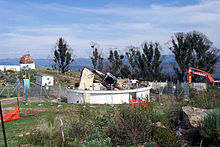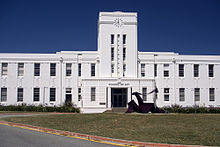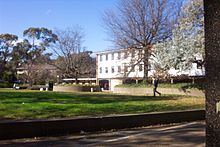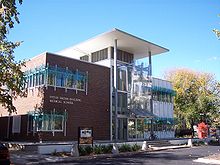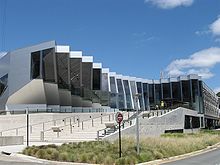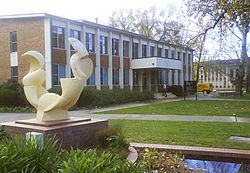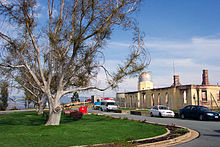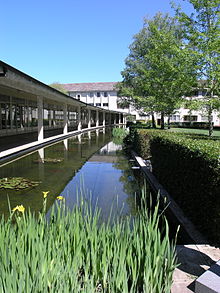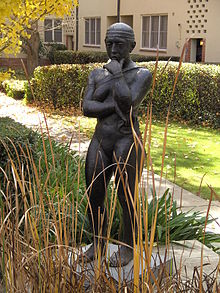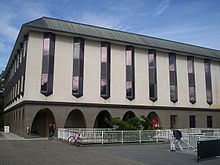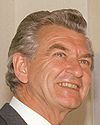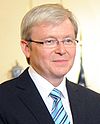- Australian National University
-
The Australian National University 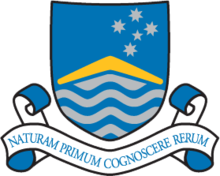
Coat of Arms of ANUMotto Naturam Primum Cognoscere Rerum
("First to learn the nature of things")Established 1946 Type Public Endowment A$1.2371 billion
(as of December 2010)[1]Chancellor Professor The Hon Gareth Evans AO QC Vice-Chancellor Professor Ian Young Admin. staff 3,945 Undergraduates 9,873 Postgraduates 7,554 Location Acton, Australian Capital Territory, Australia Campus Urban, 358 acres (1.45 km2) Affiliations Group of Eight, APRU, IARU, AURA, ASAIHL Website anu.edu.au 
The Australian National University (ANU) is a teaching and research university located in the Australian capital, Canberra.
As of 2009, the ANU employs 3,945 administrative staff who teach approximately 10,000 undergraduates, and 7,500 postgraduate students. Two Australian Prime Ministers attended the university, and the ANU includes six Nobel laureates among its staff and alumni.
The Australian National University consistently ranks among the top universities in Australia and is one of the top universities in the world in a number of fields. ANU is a member of several university alliances and cooperative networks, including the Group of Eight, the Association of Pacific Rim Universities, the Association of Universities for Research in Astronomy and the International Alliance of Research Universities.
History
20th Century
The Australian National University was established by an act of the Parliament of Australia, introduced by the then Prime Minister Ben Chifley and the Minister for Post-war Reconstruction J.J. Dedman. The bill was passed on 1 August 1946 with support of the Opposition Leader Robert Menzies. Its provisions came into effect on 7 February 1947. ANU is the only Australian university to be established by an act of the Federal Parliament;[2] all other Australian universities were established by State or Territory parliaments.
 Howard Florey
Howard Florey
A group of eminent Australian scholars were involved in the infancy of ANU, such as Sir Mark Oliphant, a leader in radar development and nuclear physics; Sir Howard Florey, a co-discoverer of the benefits of penicillin; Sir Keith Hancock, an eminent historian; and H. C. Coombs, a renowned economist and public servant.[3]
After its establishment, the University conducted research and provided only postgraduate education. Canberra University College was a tertiary education institution established in Canberra by the Australian government and the University of Melbourne in 1930. The College operated until 1960 when it was incorporated into the ANU as the School of General Studies to provide for the education of undergraduate students.
On 5 July 1960 a fire during the night destroyed much of the eastern end of the Cockcroft Building. The damage included the drawing office, many student's and staff's results and files and the control room for the 600 kV Cockcroft-Walton accelerator. The 600 kV accelerator though only water damaged had to be scrapped. Refurbishment of the burnt out area was completed in September 1961.
Early departments that have now been spun off into research schools of their own include the departments of Astronomy and Geophysics and Geochemistry. Geophysics and Geochemistry separated into the Research School of Earth Sciences in 1973. Mount Stromlo Observatory became part of the Department of Astronomy in 1957. While part of the school, the Department of Astronomy developed Siding Spring Observatory and installed many new telescopes at Mount Stromlo Observatory. It separated into the Research School of Astronomy and Astrophysics in 1986.[4]
21st Century
Walter Burley Griffin’s plan for the design of Canberra not only designated Acton peninsula as a hospital site, but did so whilst simultaneously placing it adjacent to a university where he envisaged a medical school would be located.[5] In April 2001, after intense public debate and a committee of inquiry lasting eight months, it was announced that the ANU was to develop Australia's 12th and the world's 896th medical school.[6] Shortly afterwards staff at the medical school made a proposal to the National Capital Authority that the old hospice and isolation block facilities on Acton Peninsula (which had been heritage listed for a health use) should be leased to the Medical School for teaching and clinical purposes.[7]
On January 18, 2003 the Canberra firestorm hit the Mount Stromlo Observatory, destroying five telescopes, workshops, seven homes and the heritage listed administration building. The only telescope to escape the fires was the 1868 15-centimetre Farnham telescope. Relics from the fire are preserved in the collection of the National Museum of Australia. They include a melted telescope mirror and a piece of melted optical glass (flint). The latter has pieces of charcoal and wire fused into it from the fierce heat of the fire.[8] Redevelopment is largely completed.
Arms
The ANU logo is composed of three elements: the crest, the logotype, and the name of the University. The name of the University is printed in capitalised Rotis Semi Sans. The university's coat of arms is a blue shield bearing a stylised representation of Australia beneath the stars of the Southern Cross. The motto is written on a scroll beneath the shield, Naturam Primum Cognoscere Rerum ("First to learn the nature of things").
Governance
The governing body is a 15 member Council which governs under the Australian National University Act 1991. The Council's key responsibilities include appointing the Vice Chancellor and Principal, approving the strategic direction and annual budget, establishing operational policies and procedures, and overseeing academic and commercial activities as well as risk management. The chair of the Council is the Chancellor, Professor The Hon Gareth Evans AO QC.
Endowment
In 2010, the university had an endowment of approximately A$1.2371 billion.[1]
Academic Structure and Colleges
Main article: Academic Structure of the Australian National UniversityThe ANU is divided into seven academic Colleges, which each contain a network of inter-related faculties, research schools and centres. Each College is responsible for undergraduate and postgraduate education as well as research in its respective field.
ANU College of Arts and Social Sciences
The ANU College of Arts and Social Sciences encompasses the field of humanities, creative arts and social sciences. It incorporates the Research School of Social Sciences, delivering education and research in the fields of history, philosophy, politics, international relations, and sociology; the Research School of Humanities and the Arts, including the ANU School of Music and ANU School of Art; and the Australian Demographic and Social Research Institute.
ANU College of Asia and the Pacific
The ANU College of Asia and the Pacific hosts education and research in a wide range of fields with a focus on Australia's geographic neighbourhood. The School of Culture, History and Language (which includes the former Faculty of Asian Studies) teaches and researches in the humanities and social sciences of the Asia Pacific region, as well as teaching a wide range of Asian languages. The Crawford School of Economics and Government conducts economic and public policy research on domestic, regional and international issues. The School of International, Political and Strategic Studies conducts education and research in the analysis and understanding of the international, political, societal, and strategic affairs of Asia and the Pacific. The School of Regulation, Justice and Diplomacy comprises the Asia Pacific College of Diplomacy and the Regulatory Institutions Network and conducts education and research into social and economic regulation and international diplomacy.
ANU College of Business and Economics
The ANU College of Business and Economics (CBE) comprises various schools and centres. These are the School of Accounting and Business Information Systems (ABIS), the School of Economics, the School of Finance, Actuarial Studies and Applied Statistics (FASS), the School of Management, Marketing and International Business (MMIB), the Research School of Economics (RSE) and the Research School of Business. The centres are the Centre for Applied Macroeconomic Analysis, National Centre for Information Systems Research (NCISR) and the Australian National Centre for Audit and Assurance Research.
ANU College of Engineering and Computer Science
The ANU College of Engineering and Computer Science comprises the Research School of Computer Science and the Research School of Engineering. The Research School of Information Sciences and Engineering (RSISE) was established on 1 January 1994. RSISE resulted from the merger of the Department of Systems Engineering (1981) and the Computer Sciences Laboratory (1988), both of which were part of the Research School of Physical Sciences and Engineering (RSPhysSE). The Faculty of Engineering and Information Technology (FEIT) was established in 1993, and the Research School joined in 2004 form a single institute that would become ANU College of Engineering and Computer Science (CECS) on 1 January 2006. The 2006 merger joined the undergraduate and research activities into two schools; the School of Engineering and the School of Computer Science, which were renamed as Research Schools in February 2011. The college has roughly 150 academic staff, 100 general staff, 200 higher degree by research students, and 1,000 undergraduate students. [9]
ANU College of Law
The ANU College of Law was established in 1960. The college conducts research and teaching, and engages with the community in a wide range of outreach activities such as advising government, sitting on tribunals, giving pro bono legal advice. It offers a range of undergraduate and postgraduate law programmes, as well as practical legal training through their 'Legal Workshop' programme. In addition to its academic programme, the law school promotes a range of co-curricular activities including mooting, negotiation and client interview competitions, membership of the Federal Law Review student editor board, and The ANU Law Revue.
ANU College of Medicine, Biology and Environment
The ANU College of Medicine, Biology and Environment embraces Medical Research, Life Sciences, Psychology and Environmental Science. It cover all aspects of medicine from fundamental research to clinical practice and population health. Research is carried out in areas such as agriculture, environment, neuroscience, visual science, neuroethology, health and technology.
The John Curtin School of Medical Research (JCSMR) was formed in 1948 as a result of the vision of Nobel Laureate Howard Florey and Prime Minister John Curtin. Two Nobel Prizes (John Carew Eccles in 1963 and Peter C. Doherty and Rolf M. Zinkernagel in 1996) have been won by research performed at John Curtin.
ANU College of Physical and Mathematical Sciences
The ANU College of Physical & Mathematical Sciences comprises the departments of Astronomy & Astrophysics; Chemistry; Earth Sciences; Mathematical Sciences; Physics; and Science Communication. The college contains the Research School of Physics and Engineering, a body which focuses primarily on research into materials science and engineering; lasers, nonlinear optics and photonics; nanotechnology and mesoscopic physics; physics of atoms, molecules and the nucleus; plasma physics and surface science; physics and the environment.
The Research School of Physics and Engineering was founded by Sir Mark Oliphant, its first Director from 1950 to 1963, in 1947. The school was originally called the "Research School of Physical Sciences" with "Engineering" being added to its title in 1990 to highlight the large amount of engineering work that is undertaken in the school. The name was again changed in 2008 to the "Research School of Physics and Engineering" to coincide with the merger with ANU's undergraduate physics teaching department.For much of the early years the focus of a large part of the school was designing, re-designing and building a cyclo-synchrotron that in its final intended form was to produce a beam of 10.6 GeV protons for nuclear physics research. Designed to be a world class research machine it was referred to within the school as "The Big Machine". Due to shifting goalposts and huge costs the cyclo-syncrotron was never completed. The small 7.7 MeV cyclotron designed to function as the proton injector was completed in 1955, and the large homopolar generator intended to power the system was first operated in 1962, but by this time work on "The Big Machine" itself had been abandoned.
The homopolar generator, the largest ever built, was capable of supplying currents of over 2 megaamperes. Even though it was never used for its intended purpose it ended up being used for numerous research projects requiring an extremely high current source until its disassembly in 1986. One of these projects was the invention and development of the railgun by John Barber and Richard Marshall.[10] The school also benefited in an indirect way from the construction of the massive generator, the accumulated engineering experience and techniques where later used to build other research equipment around the school including the Plasma Physics H1NF Heliac. Some parts of the homopolar generator are now on permanent display on the lawn outside the research school.
The school has been home to many different particle accelerators over the years. The first accelerator installed was a 1.25 MV Cockcroft-Walton known as HT1, this was in use from 1952 until 1967 when it was sold to the University of New South Wales. A second smaller 600 kV Cockcroft-Walton machine (HT2) was assembled in house using many spare parts acquired for HT1. In 1955 the UK government supplied a 33 MeV electron synchrotron as a gift. It was moved to the University of Western Australia in 1961. During 1960–1980 a HVEC EN tandem accelerator was used by nuclear physics for light ion research. 1975 saw the school's 14UD accelerator come online, which has since been augmented with a superconducting linear accelerator.
Centre for the Public Awareness of Science
The Centre for the Public Awareness of Science (CPAS) is a UNESCO Centre, which engages with science communication and communicators in the Pacific region and beyond. CPAS was launched in 1996 with Professor Richard Dawkins performing the opening ceremony.[11] It owes it origin to the establishment, twenty years earlier, of a modest science centre in a vacant primary school in Canberra. This burgeoning science centre eventually grew into Questacon – The National Science and Technology Centre. Questacon was the brainchild of Michael Gore,[12] a senior lecturer in Physics at the Australian National University, who became its first director. An important part of its activities was outreach, supported from the beginning by sponsorship from Shell Australia.
By 1994, the demand was so great that the Faculty of Science agreed to fund a Lectureship in Science Communication. This was the first in Australia. Dr Susan Stocklmayer[13] was appointed to the position and immediately announced her intention of establishing a university centre for science communication. The Centre was established in 1996, with Professor Bryant as its first director. Dr Stocklmayer took over the position in 1998, where she remains today.
In partnership with the UNESCO Pacific Office in Apia, Samoa,[14] CPAS has focused on science teaching training and communication in Pacific nations. As well as running a science journalism workshop for Pacific Island journalists in 2001, CPAS followed up in the same year with a science teacher workshop and the first Pacific Science Communication Forum.[15] The UNESCO office in Jakarta[16] invited CPAS to join a mission to Cambodia to conduct a survey to identify and assess the needs of the country with respect to science education in schools and universities. Other activities include joining with UNESCO (Apia) to help in its aims to raise social participation in science in and around the Pacific. CPAS also established, as a pilot project, the Register of Pacific Scientists, an online database for those involved with Pacific Science to record their details and/or search for other people with similar or complementary interests. Other activities of CPAS include the presentation of workshops for secondary school science teachers and others in Fiji, India, Sri Lanka, Thailand, Japan and New Zealand. A joint teaching program is being developed with the National University of Singapore. In South Africa, CPAS helped to develop a touring hands-on science exhibition and has been invited to work in and with various South African science centres.
In subsequent years, the work of CPAS has been recognised by a number of awards and honours: In 1999, CPAS, Shell Australia and Questacon jointly won the Business/Higher Education Round Table[17] Award. The citation commends CPAS as “a university centre whose brief is to empower Australians by encouraging in them the confidence of 'ownership' of modern science. It is intended to increase science awareness in the Australian community and to improve communication skills of scientists.” In 2000, it was designated as the first UNESCO Centre for Science Communication.
ANU E Press
The ANU E Press is hosted by the Division of Information at The Australian National University. It was established in 2003 to produce electronic scholarly books and journals. These are available free on-line as web pages and ebooks. Also, publications can be ordered on paper through a Print on Demand (PoD) service.
Campus
Acton
The university's main campus occupies most of the Canberra suburb of Acton. The campus covers 1.45 square kilometres (360 acres) adjoining native bushland, Black Mountain, Lake Burley Griffin, the suburb of Turner and the city centre. The ANU campus is divided into eight precincts, with three on the west side of Sullivans Creek; Dickson Precinct, Linnaeus Precinct, Daley Precinct; and five on the east side; Kingsley Precinct, Baldessin Precinct, Ellery Precinct, Liversidge Precinct and Garran Precinct. With over 10,000 trees on its campus, the ANU was awarded the Silver Greenhouse Challenge Award at the annual Australian Engineering Excellence Awards in 2003.
Other Campuses
The Research School of Astronomy and Astrophysics (RSAA) is located away from the main campus in Acton, at the Mount Stromlo Observatory, near Weston Creek in south Canberra. RSAA also runs the Siding Spring Observatory near Coonabarabran, New South Wales. Since the destruction of Mount Stromlo's telescopes in the Canberra bushfires of 2003, this is university's only telescope site. The university also runs a coastal campus at Kioloa on the South Coast of New South Wales dedicated to field work training, and a North Australia Research Unit in Darwin in the Northern Territory.
Undergraduate students on all campuses are represented by the ANU Students' Association. Postgraduate students are represented by the Postgraduate and Research Students' Association (PARSA), a member of the Council of Australian Postgraduate Associations. The Australian National University Union provides representation to all students in the provision of catering and retail services as well as functions amenities.
Residential Halls and Colleges
Eight of the university's nine affiliated halls and colleges are located on campus, while Fenner Hall is located on Northbourne Avenue in the nearby suburb of Braddon. The halls and colleges are: Bruce Hall, Ursula Hall, Fenner Hall, Burgmann College, John XXIII College, Burton & Garran Hall, UniLodge Davey, UniLodge Kinloch, Unilodge Warrumbul, Toad Hall, University House and Graduate House. In 2010, Griffin Hall, a non-residential college, was established for students living off-campus.
Burgmann and neighbouring John XXIII College are the only remaining independent residential colleges among the Australian National University's ten halls of residence. Burgmann and John XXIII continue to administer their own admissions processes separate from the university's central clearinghouse for accommodation.
Although the University accommodation houses more than 3,700 students, the ANU suffers from chronic shortage of student accommodation, due in part to over-enrolment.[18]
Collaborations and Memberships
ANU is a member of several university alliances and cooperative networks, including the Group of Eight, the Association of Pacific Rim Universities, the Association of Universities for Research in Astronomy and the International Alliance of Research Universities.
Library System
Main article: Australian National University Library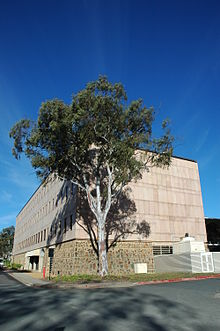 R. G. Menzies Building
R. G. Menzies Building
The Australian National University Library is part of the ANU's Division of Information. The Australian National University Library began with the appointment of the first University Librarian, Arthur Leopold Gladstone McDonald in early 1948. The establishment of the ANU Library was deemed so important to the development of the University, that McDonald was appointed by the Interim Council before any of the professors.
Initially McDonald and several assistants were housed in Ormond College at the University of Melbourne, where they began to form the collection. At the end of 1950s the collection, which had grown to approximately 40,000 volumes, was transferred to Canberra, to be located in the Canberra Community Hospital and nearby huts. Over the course of the 1950s the collection grew steadily, and by the time of McDonald's retirement in the 1960s, the collection had grown to 150,000 volumes.
The ANU Library collection is housed in four main locations; the R.G. Menzies Building (Asia Pacific material); the J.B. Chifley Building (Social Sciences & Humanities material); the W.K. Hancock Building (Science material); and the Law Library in the Law School Building. Additional services are provided by five science branch libraries: Art Library, Chemistry Branch Library, Earth Sciences Branch Library, Eccles Medical Sciences Library and Music Library. The ANU owns a collection of rare books, housed in a closed access collection held in the Rare Book Room in the R.G. Menzies Building.
Rankings
The following publications ranked universities worldwide.
Publications 1999 2000 2001 2002 2003 2004 2005 2006 2007 2008 2009 2010 2011 Comments Times Higher Education-QS World University Rankings 16 23 16 16 16 17 20 26 Ranking within Australia: 1, 2, 1, 1, 1, 1, from 2004 to 2009 respectively. Times Higher Education World University Rankings 43 38 Ranking within Australia: 2 in 2010. QS World University Rankings 20 26 Ranking within Australia: 1 in 2010. Shanghai Jiao Tong University Academic Ranking of World Universities[19] 49 53 53 54 57 59 59 59 70 Ranking within Australia: 1, 1, 1, 1, 1, 1, 1, 1 from 2003 to 2010 respectively. The University currently has the highest ranking for universities in Australia. It is also one of the highest ranked universities in Asia[20] and the Southern Hemisphere according to several compilations, including the Academic Ranking of World Universities,[21] the Times Higher Education World University Rankings and the QS World University Rankings (the latter two were amalgamated as the THE-QS World University Rankings until 2010).[22] The Australian National University is the second highest ranked university outside North America and Britain, after ETH Zurich.
The QS World University Rankings[23] consistently ranks the Australian National University highly. In 2011 it was ranked first in Australasia and twenty-sixth in the World, one below the University of Tokyo, one above King's College London. It has dropped nine places since the 2009 THE-QS World University Rankings (in 2010 Times Higher Education World University Rankings.[24] and QS World University Rankings parted ways to produce separate rankings) where it came seventeenth globally.
Notable graduates
Main article: List of Australian National University peopleAcademic leaders have included Professors Manning Clark, Bart Bok, Derek Freeman, and Hanna Neumann. Notable political alumni include former Prime Ministers of Australia Bob Hawke (who did not graduate) and Kevin Rudd, current Premier of New South Wales Barry O'Farrell, Patricia Hewitt, and Kim Edward Beazley. Alumni in other fields include Supreme Court Judge Catherine Holmes, linguist Nicholas Evans and mathematician John H. Coates.
Nobel prize winners associated with the University include Lord Howard Florey, an early academic adviser to ANU and Chancellor from 1965–1968 and Professor John Eccles awarded in 1963 for Medicine – for his pioneering work on aspects of the mammalian central nervous system. Professor Eccles was founding Professor of Physiology at The John Curtin School of Medical Research. Professor John Harsanyi received the 1994 Nobel Prize for Economics for his work on game theory, providing a new tool for economic analysis. Professor Harsanyi taught economics at ANU from 1958 to 1961, completing some of his early research on game theory while at the University. Professor Rolf M. Zinkernagel and Professor Peter Doherty received the 1996 Nobel Prize for Medicine for their revolutionary work in immunology; Professors Doherty and Zinkernagel first met and worked together at The John Curtin School of Medical Research. In 2011, Brian P. Schmidt shared the Nobel Prize in Physics with Saul Perlmutter and Adam Riess for observations which provided evidence for the accelerating Universe.
See also
- Australian National University Library
- Australian National University Student Association
- Australian National University Union
- List of Australian National University people (notable alumni and faculty)
- NICTA – National Information and Communication Technology Research Centre, co-founded by ANU
- Woroni – The ANU student newspaper
- Group of Eight (Australian universities)
References
- ^ a b [1], ANU, December 2010
- ^ "ANU History". Anu.edu.au. 2010-11-04. http://www.anu.edu.au/about/history.php. Retrieved 2011-10-01.
- ^ Foster, S.G.; Varghese, M.M. (1996). The making of the Australian National University 1946-1996. Sydney: Allen & Unwin. ISBN 1864480831.
- ^ Ophel, Trevor; Jenkin, John (1996). Fire in the belly : the first 50 years of the pioneer school at the ANU. Canberra: Research School of Physical Sciences and Engineering, Australian National University. p. 157. ISBN 0-85800-048-2. http://wwwrsphysse.anu.edu.au/admin/php/history.php.
- ^ J Birrell, Walter Burley Griffin University of Queensland Press 1964, 92–93
- ^ Paul A Gatenby and Nicholas J Glasgow. A medical school for the Australian National University. MJA 2002 177 (11): 8–9
- ^ John-Paul Moloney. ANU Medical School 'frozen out' of talks on hospice. Canberra Times 09 Jul, 2002 http://www.canberratimes.com.au/news/local/news/general/anu-medical-school-frozen-out-of-talks-on-hospice/334938.aspx accessed 15 January 2010.
- ^ "NMA Collections Search - Piece of clear optical glass (flint), a relic from the 2003 bush fire that destroyed the Mount Stromlo Observatory". Nma.gov.au. 2003-01-18. http://www.nma.gov.au/collections-search/display?irn=71133. Retrieved 2011-10-01.
- ^ "ANU College of Engineering and Computer Science". Cecs.anu.edu.au. 2010-12-24. http://cecs.anu.edu.au/. Retrieved 2011-10-01.
- ^ Marshall, Richard (2001). "Railgunnery: Where Have We Been? Where Are We Going?". IEEE Transactions on Magnetics, 37 (1), 440–444.
- ^ "CPAS Launch". CPAS. ANU. http://cpas.anu.edu.au/about-cpas/cpas-launch. Retrieved 2011-10-22.
- ^ "Adjunct Professor Mike Gore AM". CPAS. ANU. http://cpas.anu.edu.au/person/adjunct-professor-mike-gore-am. Retrieved 2011-10-22.
- ^ "Associate Professor Sue Stocklmayer AM". CPAS. ANU. http://cpas.anu.edu.au/person/associate-professor-sue-stocklmayer-am. Retrieved 2011-10-22.
- ^ "UNESCO Pacific Office in Apia, Samoa". Portal.unesco.org. 2011-08-24. http://portal.unesco.org/en/ev.php-URL_ID=36986&URL_DO=DO_TOPIC&URL_SECTION=201.html. Retrieved 2011-10-01.
- ^ "CPAS - a UNESCO centre". CPAS. ANU. http://cpas.anu.edu.au/cpas-unesco-centre. Retrieved 2011-10-22.
- ^ "UNESCO Office in Jakarta, Indonesia". Unesco.or.id. http://www.unesco.or.id. Retrieved 2011-10-01.
- ^ "Business/Higher Education Round Table". Bhert.com. http://www.bhert.com/. Retrieved 2011-10-01.
- ^ Gilmore, Heath (15 February 2010). "No room at the inn ... or the university". The Sydney Morning Herald. http://www.smh.com.au/national/education/no-room-at-the-inn--or-the-university-20100214-nzkx.html.
- ^ Institute of Higher Education, Shanghai Jiao Tong University.
- ^ "QS World University Rankings® 2011/2012". Top Universities. http://www.topuniversities.com/university-rankings/world-university-rankings/2010/results. Retrieved 2011-10-01.
- ^ "Academic Ranking of World Universities 2010 rankings". Arwu.org. http://www.arwu.org/ARWU2010.jsp. Retrieved 2011-10-01.
- ^ "Times Higher Education - World University Rankings, education news and university jobs". Thes.co.uk. http://www.thes.co.uk/statistics/international_comparisons/2006/top_unis.aspx?window_type=popup. Retrieved 2011-10-01.
- ^ "QS World University Rankings". Topuniversities. http://www.topuniversities.com/university-rankings/world-university-rankings/2011. Retrieved 2011-10-01.
- ^ "QS World University Rankings 2009 – Top 200 Universities". Timeshighereducation.co.uk. http://www.timeshighereducation.co.uk/hybrid.asp?typeCode=438. Retrieved 2011-10-01.
External links
Coordinates: 35°16′40″S 149°07′14″E / 35.2778°S 149.1205°E
Australian National University Campuses The Colleges ANU College of Arts and Social Sciences • ANU College of Asia and the Pacific • ANU College of Business and Economics • ANU College of Engineering and Computer Science • ANU College of Law • ANU College of Medicine and Health Science • ANU College of Physical & Mathematical SciencesThe Institute of Advanced Studies Research School of Astronomy and Astrophysics • Research School of Biological Sciences • Research School of Chemistry • Research School of Earth Sciences • Research School of Information Sciences and Engineering • Research School of Pacific and Asian Studies • Research School of Physical Sciences and Engineering • Research School of Social Sciences • The John Curtin School of Medical Research • The Centre for Resource and Environmental StudiesUniversity Centres Asia Pacific College of Diplomacy • Crawford School of Economics and Government • Australian Primary Health Care Research Institute • Centre for Aboriginal Economic Policy Research • Centre for Applied Philosophy and Public Ethics • Centre for Cross-Cultural Research • Centre for Mental Health Research • Centre for the Public Awareness of Science • Humanities Research Centre • National Centre for Epidemiology and Population Health • National Graduate School of Management • Mathematical Sciences Institute • National Europe Centre • Centre for Arab and Islamic StudiesResidence Halls and Colleges Bruce Hall • Ursula Hall • Fenner Hall • Burgmann College • John XXIII College • Burton & Garran Hall • Toad Hall • University House • Graduate House Universities in Australia
Universities in AustraliaAustralian Capital Territory Australian Defence Force Academy (UNSW accredited degrees) · Australian National University · University of Canberra
New South Wales Northern Territory Queensland South Australia University of Adelaide · University of South Australia · Flinders University · Heinz College, Australia · UCL, Australia
Tasmania Victoria Western Australia National Group of Eight University of Adelaide • Australian National University • University of Melbourne • Monash University
University of New South Wales • University of Queensland • University of Sydney • University of Western AustraliaAssociation of Pacific Rim Universities (APRU) China Hong Kong Japan South Korea Russia Canada Mexico United States Caltech · Stanford · UC Berkeley · UC Davis · UC Irvine · UCLA · UCSD · UCSB · Oregon · Southern California (USC) · WashingtonAustralia New Zealand Chile Indonesia Malaysia Philippines Singapore Taiwan Thailand International Alliance of Research Universities (IARU) ANU • UC Berkeley • Cambridge • Copenhagen • ETH Zurich • Oxford • Peking • NUS • Tokyo • Yale
Categories:- Australian National University
- Association of Pacific Rim Universities
- National universities
- Universities in the Australian Capital Territory
- 1946 establishments in Australia
Wikimedia Foundation. 2010.


